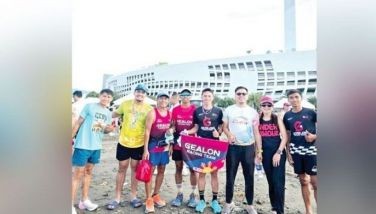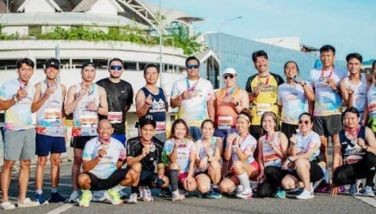Cycling for fitness
When one is new to cycling, what often comes to mind is the kind of bike you will need. We have BMX, unicycle, folding bike, single speed bike fixie, downhill bike, mountain bike (MTB), road bike, and time trial bike or tri bike (TT bike).
Let us focus on the bike that I am familiar with, which are mountainbike, road bike and TT Bike.
As a newbie to the sport, I always recommend the MTB mainly because it is the easiest in terms of handling, braking and maneuverability. And because of the tire size, you are less prone to slipping and falling of your bike. The MTB can be ridden almost anywhere from our streets, mountain rides, trail or off road ride, fire road etcetera. Then there is a question of tire size 26, 27.5 and 29. The disadvantage of the MTB is it slower in flat street or road compared to the road or TT bike. But again, it depends on your fitness level. Some cyclists can pedal the MTB with the speed ranging from 30-50 kph. Most of the MTB are now fitted with disc brake so even on wet and muddy surface, the brake is pretty reliable in term stopping power. There are only a few MTB races and usually it starts very late, most often caused by cyclists sandbagging as to what division they are racing.
Road bike is light and fast, far different from the MTB. The maneuverability and handling is much more challenging compared to the MTB, but once you get used to the system, it blasts away in terms of speed. The brake and the shifter are on same levers unlike years before wherein the shifter is located either on the top tube, which is very dangerous and risky, because at some point while shifting, only one hand is on the handle bars. Road bike is harder to brake and shift compared to the MTB. Races are scheduled almost every weekend and every morning at SRP in Talisay. There are also challenging races through the transcentral highway in Balamban and all the way to the tops.
The time trial bike is the most aerodynamic among the three. This bike is used for team or individual time trial races and most common bike use for triathleles, which drafting is not allowed. TT bike is also designed for a more comfortable position. Your elbow is on the handle bars which are called the aero bar. This position will help you cut through headwind more efficiently and reducing drag. The angle of the seat post is leaning forward, you will be using mostly your quads muscle instead of your hamstrings, which will make your run easier. But does that not mean you need to get a TT bike for triathlon if one has an existing road bike. He or she has to learn to spin and keep the pace up around above 30kph before upgrading to a TT bike. Shifting and braking is challenging for the TT bike because the shift levers are located on the aero bars and the brake are located on the handle bars.
On the other hand, here are some health benefits of cycling:
When you hold a human heart in your hand, it feels like a fillet mignon, only it is hollow, basically it is just muscle. The heart responds to exercise the same way ordinary muscle does, just as your chest expands with bench press or push up. Your heart grows with prolonged exercise. A trained heart can be about 30-40 percent larger than the normal one. Hence, it can pump more blood with every beat. This medical condition is known as athlete's heart. One of the main benefits of having an athlete's heart is your heart rate will slow down. Because it is pumping more blood with every contraction, and heart does not need to beat that often, especially if you are sleeping, resting, or any non strenous daily activities. The average heart has a resting heart rate of 66 to 75 beats per minute ( take yours right now, put a couple of fingers alongside your adams apple for 30 seconds as you quietly read this and double the count).
By comparison, many well-trained endurance athletes have pulse around 40 when they wake up. Former 7-time Tour de France winner Lance Armstrong's resting heart rate was mind boggling 27. I have recorded mine at 37 bpm upon waking up, compared to before when I was overweight which was around 68 to 70 bpm. Yours will probably never get that low, but it will decrease below average when you get fitter. Also, please be reminded to consult your doctor before doing any exercise. A quick visit to your cardiologist will save your life. With the increase incident on pulmonary embolism, blood clot, stroke or valve failure, it will never hurt to get that stress test and EKG test.
Healthy knees are guaranteed for cycling because cycling is almost a non-weight bearing exercise. Your knees will thank you for doing cycling instead of running, as we all know the impact of run not only your knee but your ankle, and other joints as well. Cycling is the rehabilitation of choice of most knee injuries. Physical therapists know that when you can' t run or walk, often you can pedal a bicycle.
But there are potential wear and tear on cartilage, ligaments and tendons. Imagine an average cadence of 90 revolutions per minute a cyclist cranks out around 5,400 strokes each hour and about 1.5 million in a 5,000 mile year. There are lots of factor that would affect your knee from riding position like too low, or too forward, squatting like a frog on a saddle, (like what most spinning class instructor asks you to do in Cebu). Pedal alignment or cleats alignment is also vital especially most of the cycling shoes have stiff and rigid soles. You can have your cleat positioned by a coach, or a bike shop.
For best cycling fitness result, always remember to warm up. Spin don't push, build mileage gradually, don't grind up hills while seated. When strain increases, stand and you will be a more efficient climber out of the saddle.
Cycling is a great exercise but it does not make you immune in gaining weight. Some go for an enjoyable ride with a group, but it does not give you to the right to feast after each long ride. You have to be mindful of what you eat, remember the excess weight you carry on, will affect the speed of the bike. Like for a kilo it gives you an extra one minute to finish a 10 kilometer uphill climb. A well known German cyclist who won the 1997 Tour de France gained nearly 20 lbs in the off season, then struggled to get back the to racing weight despite logging in miles and miles of hard training and racing. Weight control is easier if you don't gain that much during the off season.
Hope to see you guys on the road. And remember that to always wear your helmet while biking, keep your eyes on the road and be alert because most of our drivers - from jeepney to taxi and even habal habal drivers - have no respect to cyclists.
- Latest




















